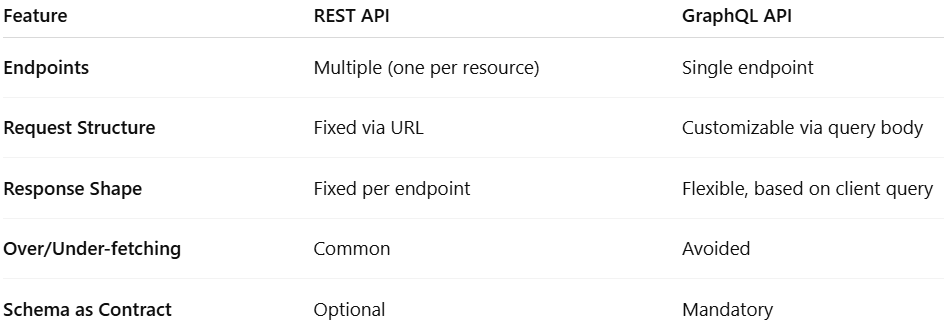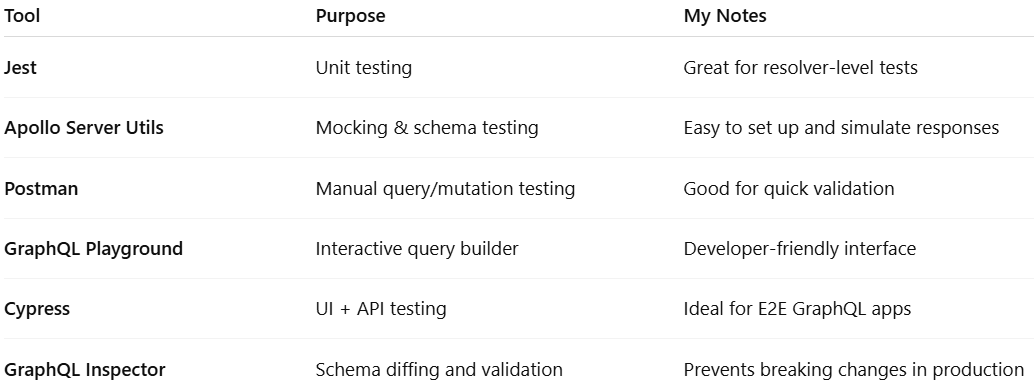 OTHERS
OTHERS GraphQL Testing: The Ultimate QA Guide (From Pain to Perfection)

From Chaos to Control: My Wake-Up Call with GraphQL
Two years ago, I was pulled into a critical sprint on a fintech project. We were replacing REST APIs with GraphQL. Everyone was thrilled… except QA.
Why? Because our existing test suite fell apart the moment GraphQL entered the scene. The devs were pushing schema updates daily. Our tests failed without clear reasons. Bugs slipped into production.
We had gone from confident releases to chaotic hotfixes. That was the wake-up call. I had to relearn API testing from the ground up—this time, the GraphQL way.
What came out of that firestorm was a powerful, repeatable GraphQL testing strategy—and that’s exactly what I’m sharing with you today. 💡
🧠 1. What is GraphQL, and Why Test It Differently?
Let’s be honest—GraphQL flips everything you knew about API testing on its head.
🔄 REST vs. GraphQL: Key Differences for QA

🚨 Reality Check: You can't apply the same REST testing rules to GraphQL. You'll either under-test or over-complicate.
🔍 2. Why GraphQL Demands a New Testing Mindset
When I first started, I thought testing GraphQL would be easier—fewer endpoints, right? Wrong. Here's why:
- Clients define the shape of the response 🧩 —so you need to test combinations, not just endpoints.
- Schema acts as both documentation and contract 📜 —so test coverage starts from the schema, not the UI.
- Resolvers pack business logic 💼 —so unit testing isn't optional.
It took me weeks to unlearn REST habits. But once I embraced GraphQL’s structure, testing became far more focused—and effective.
🧪 3. The Four Core Types of GraphQL Testing
To properly cover a GraphQL API, I break testing into four main layers. Each has its own tools, goals, and scope.
🧩 3.1 Unit Testing (Resolvers)
Unit testing is about isolating and validating individual resolver functions.
✅ Pro Tip: Mock external dependencies like databases or services. I use Jest with resolver mocks.
Example:
js
CopyEdit
expect(myResolver({}, {}, { dataSources })).toEqual(expectedResult);
🔗 3.2 Integration Testing
This tests how resolvers interact with each other and with the schema.
- Test full query execution through Apollo Server
- Include middleware like auth, logging, or caching
🔍 I simulate requests using supertest or apollo-server-testing.
🚀 3.3 End-to-End (E2E) Testing
E2E tests simulate real-world usage: front end calling the API and validating output.
🧪 Tools I use:
- Cypress (with GraphQL plugin)
- Playwright (great for UI + API combo testing)
Example:
- UI submits a signup form → mutation triggers → database updates → UI confirms success
📜 3.4 Contract Testing
GraphQL schemas are contracts. I use GraphQL Inspector to catch breaking changes like:
- Removed fields
- Changed return types
✅ Pro Tip: Automate schema checks in CI/CD to prevent schema regressions!
🛠️ 4. Best Tools for GraphQL Testing (That I Actually Use)
Here’s my personal toolkit 🧰 —tried, tested, and trusted in production.

✅ Reality Check: Don’t rely on just one tool—combine them for maximum coverage.
🧠 5. How I Write Killer GraphQL Test Cases
Over the years, I’ve created a simple checklist I follow for every GraphQL test suite. Here’s what works:
✅ GraphQL Test Case Checklist
- Start with the schema
- Test all query/mutation combinations
- Cover nulls, optional fields, edge cases
- Mock external services
- Include authorization failures
- Validate error formats (not just success paths)
📌 Before: We had 20 test cases, mostly happy path.
📌 After: We added schema-driven cases and error handling—tests increased to 60+ but bugs dropped by 90% in the next release.
🧪 6. My Real-World GraphQL QA Workflow (That Works Every Time)
Here’s the exact process I follow with my QA team when testing any GraphQL project:
🔄 Step-by-Step Workflow
- Understand the schema
- Use Playground or SDL to map all fields and types.
- Create a test matrix
- Include queries, mutations, edge cases, roles (auth), and failure states.
- Write unit tests for resolvers
- Mock dependencies and validate logic.
- Write integration tests
- Send real queries to test schema flow.
- Write E2E tests with UI triggers
- Simulate real users from frontend to DB.
- Automate schema diff checks
- Stop regressions before they hit staging.
🧠 Pro Tip: Always version your GraphQL schema and store test coverage reports with builds.
⚠️ 7. Common GraphQL Testing Mistakes I’ve Made (So You Don’t Have To)
Let me save you some time (and pain). Here are the top mistakes I’ve made in GraphQL testing—and how to avoid them:
❌ Mistake #1: Only Testing Happy Paths
🔥 Fix: Always test invalid inputs, missing fields, and auth failures.
❌ Mistake #2: Ignoring Schema Changes
🔥 Fix: Automate schema checks in CI to catch breaking changes early.
❌ Mistake #3: Over-Mocking
🔥 Fix: Use mocks in unit tests only. For integration and E2E, use real or staging data.
❌ Mistake #4: Skipping Query Depth Tests
🔥 Fix: Add complexity limits to avoid denial-of-service queries.
⚡ 8. Performance Testing in GraphQL (Yes, It Matters!)
GraphQL lets clients fetch lots of data in a single call. That’s great—until performance tanks. 😬
Here’s how I keep it in check:
🚀 GraphQL Performance Tips
- Add query complexity analysis
- Block deeply nested queries that can slow down your server.
- Use Apollo Tracing or custom metrics
- Measure resolver execution times and identify bottlenecks.
- Test with real-world payloads
- Use staging data to measure performance under load.
📊 On one project, we reduced average query time from 450ms to 120ms just by flattening nested queries and using better batching.
🔐 9. Security Testing in GraphQL: What You Can’t Ignore
GraphQL introduces new risks that REST doesn’t have.
🛡️ Must-Do Security Tests
- Disable schema introspection in production
- Add depth and complexity limits to prevent abuse
- Test for field-level authorization
- Validate query inputs to block injections
🧠 Reality Check: One client app exposed private employee data via an unguarded field. Schema passed all functional tests—but failed authorization. Lesson learned.
💬 10. FAQ – GraphQL Testing Questions You Might Be Afraid to Ask
❓ What is GraphQL testing?
GraphQL testing is validating that your queries, mutations, and schemas work as intended—under real, edge-case, and error conditions.
❓ How is GraphQL testing different from REST?
REST testing relies on fixed endpoints. GraphQL allows dynamic queries, so you need schema-based and query-specific test strategies.
❓ Can I use Postman to test GraphQL?
Yes, but it's limited to manual testing. Use automation tools like Jest, Apollo, or Cypress for real coverage. Also check Cypress questions and answers.
❓ Should I test every query?
You should test every major use case—especially ones that touch business logic or critical data.
❓ How do I prevent breaking changes in GraphQL?
Use schema diff tools like GraphQL Inspector and integrate them with your CI pipeline.
✅ 11. Action Plan: Your GraphQL Testing Launch Checklist
Here’s what to do if you want to stop bugs, own your testing, and finally feel confident in GraphQL QA:
🚀 GraphQL Testing Kickstart
- Analyze and map your GraphQL schema
- Write unit tests for resolvers
- Set up integration tests with real/mocked data
- Add Cypress tests for real E2E scenarios
- Implement schema diff checking in CI
- Test for security issues (auth, depth, inputs)
- Set up performance benchmarking
🎯 Bonus Tip: Celebrate your first bug-free deployment—your future self will thank you!
🙌 Final Thoughts: From Overwhelm to Mastery
Testing GraphQL isn’t just a checkbox—it’s your QA superpower in the modern API world.
Once I embraced schema-driven thinking, got the right tools, and stopped treating GraphQL like REST, everything changed:
✅ Fewer regressions
✅ Happier developers
✅ Confident, repeatable releases
If you’re starting your GraphQL QA journey, take it from someone who’s been there—don’t wing it, test it.